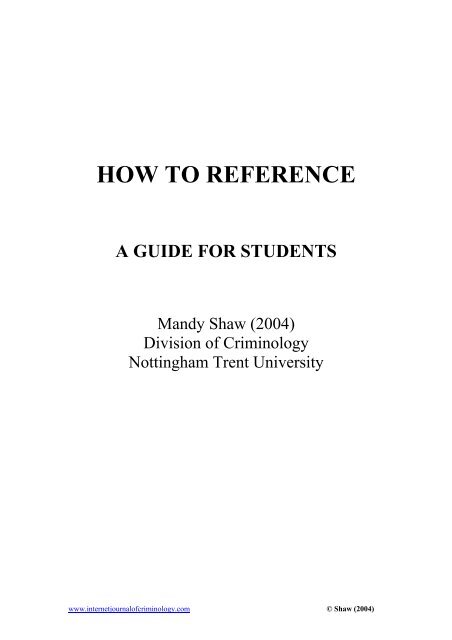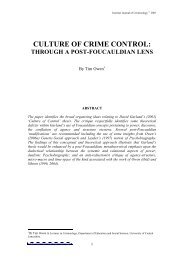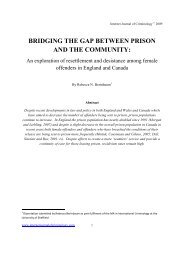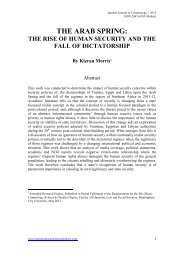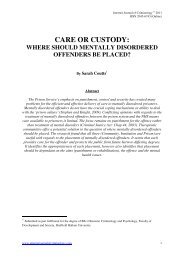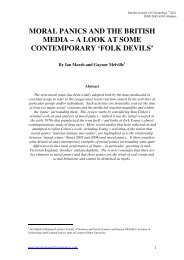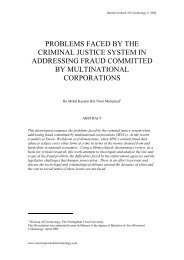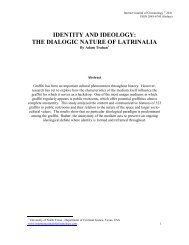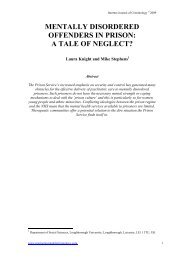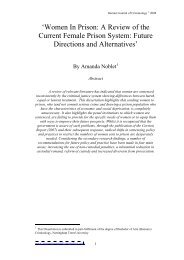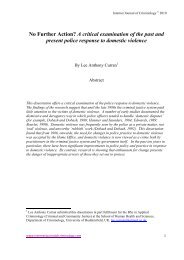HOW TO REFERENCE - Internet Journal of Criminology
HOW TO REFERENCE - Internet Journal of Criminology
HOW TO REFERENCE - Internet Journal of Criminology
Create successful ePaper yourself
Turn your PDF publications into a flip-book with our unique Google optimized e-Paper software.
<strong>HOW</strong> <strong>TO</strong> <strong>REFERENCE</strong><br />
A GUIDE FOR STUDENTS<br />
Mandy Shaw (2004)<br />
Division <strong>of</strong> <strong>Criminology</strong><br />
Nottingham Trent University<br />
www.internetjournal<strong>of</strong>criminology.com © Shaw (2004)
CONTENTS PAGE<br />
What is referencing? 3<br />
Why is it important to reference properly? 3<br />
What is plagiarism? 3<br />
How is plagiarism viewed at university? 4<br />
Example - how to refer to someone else’s work 4<br />
What is the correct way to quote directly? 4<br />
An example <strong>of</strong> plagiarism 6<br />
What is the correct way to paraphrase the words <strong>of</strong> an author? 6<br />
What is the correct way to refer to the ideas <strong>of</strong> an author? 7<br />
What is the correct way to quote words from one author<br />
which are quoted in a different author’s work<br />
(secondary referencing)? 7<br />
What is the correct way to write a quotation within 7<br />
a quotation?<br />
What is the correct way to set out a reference list? 7<br />
www.internetjournal<strong>of</strong>criminology.com 2<br />
© Shaw (2004)
This Guide shows you how to reference using the Harvard system in your academic<br />
written work at university. It starts by addressing why referencing is important. The<br />
issue <strong>of</strong> plagiarism is also addressed. Basic principles to adopt in referencing in the<br />
body <strong>of</strong> an essay/assignment are given and applied to an example. The Guide then<br />
turns to address how to reference in a reference list, adapting the same example.<br />
WHAT IS REFERENCING?<br />
Referencing is when you attribute the source <strong>of</strong> words, ideas and data you use<br />
to the author(s) whose work you have read.<br />
Referencing refers to other people’s work which you directly quote from and<br />
other people’s work whose words you use less directly.<br />
WHY IS IT IMPORTANT <strong>TO</strong> <strong>REFERENCE</strong> PROPERLY?<br />
It is vital to attribute sources throughout all assessments, so that you are not<br />
accused <strong>of</strong> plagiarism (see next section).<br />
Many different sources are available to be used nowadays (books, journal<br />
articles, videos, etc.). Authors whose work is not correctly referenced are<br />
more likely now than ever before to bring legal action if they find out that<br />
their words have been used improperly.<br />
If you do not reference properly, you could be accused <strong>of</strong> intellectual theft.<br />
Proper referencing encourages a good academic writing style.<br />
Out <strong>of</strong> respect for other people.<br />
Good referencing saves detailing in full the argument or information referred<br />
to. This can save on the word count.<br />
People reading your work may wish to follow up, out <strong>of</strong> interest, references<br />
you have used.<br />
You will be penalised if you do not reference properly.<br />
WHAT IS PLAGIARISM?<br />
Plagiarism is intellectual theft.<br />
Plagiarism is when the words and ideas <strong>of</strong> another author are used and the<br />
source is not acknowledged.<br />
Plagiarism most commonly happens when students copy words (sentences or<br />
whole paragraphs) and do not put them in quotation marks and do not name<br />
the author and full reference.<br />
<strong>HOW</strong> IS PLAGIARISM VIEWED AT UNIVERSITY?<br />
To pass <strong>of</strong>f someone else’s words as your own represents a serious breach <strong>of</strong><br />
universities’ academic irregularities policies.<br />
Plagiarism is considered very seriously.<br />
You could be removed from your programme <strong>of</strong> study if you are found to be<br />
guilty <strong>of</strong> plagiarism.<br />
In addition, copying another student’s work and passing that <strong>of</strong>f as your own<br />
is also considered an academic irregularity and is viewed extremely seriously.<br />
www.internetjournal<strong>of</strong>criminology.com 3<br />
© Shaw (2004)
Although you may wish to discuss the subject focus <strong>of</strong> an item <strong>of</strong> coursework<br />
with other students, the submitted piece must be independently written and<br />
entirely your own work (for example, choose your own quotations and<br />
examples to illustrate points made).<br />
EXAMPLE - <strong>HOW</strong> <strong>TO</strong> REFER <strong>TO</strong> SOMEONE ELSE’S WORK<br />
The next few sections will illustrate how to refer to the following hypothetical<br />
original text in different ways and which ensure that the source is correctly<br />
referenced.<br />
Repeat victimisation is both an effective crime prevention and crime reduction<br />
tool. Crime prevention opportunities are evident because the location and<br />
timing <strong>of</strong> future crimes can be predicted, by looking at the location and timing<br />
<strong>of</strong> past crimes. Crime detection opportunities are evident because it is known<br />
that the same criminals may return to a location which they have previously<br />
targeted (Jones, 2002, p.3).<br />
WHAT IS THE CORRECT WAY <strong>TO</strong> QUOTE DIRECTLY?<br />
Like this:<br />
Repeat victimisation is a tool which can be used to predict crime. It has been<br />
suggested that ‘Crime prevention opportunities are evident because the location and<br />
timing <strong>of</strong> future crimes can be predicted, by looking at the location and timing <strong>of</strong> past<br />
crimes’ (Jones, 2002, p.3)*.<br />
Or like this:<br />
Repeat victimisation is a tool which can be used to predict crime. It has been<br />
suggested that ‘Crime prevention opportunities are evident because the location and<br />
timing <strong>of</strong> future crimes can be predicted, by looking at the location and timing <strong>of</strong> past<br />
crimes’ (Jones, 2002: 3)*.<br />
* Both ways <strong>of</strong> referring to the page number are acceptable in any form <strong>of</strong> reference,<br />
i.e. in all the examples in the rest <strong>of</strong> this Guide. Just be consistent. If you decide to<br />
use the 2002, p.3 method, use throughout your piece <strong>of</strong> work. Similarly, if you decide<br />
to use the 2002: 3 method, use it throughout.<br />
Direct quotations should be used with single quotation marks.<br />
If the quotation is quite short (up to about 40 words), the quotation should<br />
appear in the middle <strong>of</strong> a sentence, as above.<br />
If the quotation is relatively long (more than 40 words), the quotation should<br />
be presented as an indented paragraph (see section immediately before this<br />
one). If you indent, you do not have to include quotation marks.<br />
www.internetjournal<strong>of</strong>criminology.com 4<br />
© Shaw (2004)
If you want to exclude some words from the quotation, it is acceptable to do<br />
this providing you show that you have excluded some words by inserting three<br />
dots. In the example here, it is acceptable to write – It has been suggested that<br />
‘ … the location and timing <strong>of</strong> future crimes can be predicted, by looking at<br />
the location and timing <strong>of</strong> past crimes’ (Jones, 2002, p.3).<br />
Sometimes, words are emphasised by the author being quoted (like this, like<br />
this, or like this). You should include any emphasis which occurs in the<br />
original words. At times, you may wish to add your own emphasis. You can<br />
do this providing you say that you have added the emphasis, e.g. It has been<br />
suggested that ‘Crime prevention opportunities are evident because the<br />
location and timing <strong>of</strong> future crimes can be predicted, by looking at the<br />
location and timing <strong>of</strong> past crimes’ (Jones, 2002, p.3, emphasis added).<br />
AN EXAMPLE OF PLAGIARISM<br />
The following are examples <strong>of</strong> incorrect ways <strong>of</strong> using someone else’s words. The<br />
problematic words have been underlined to show the reason why the format is<br />
incorrect:<br />
Like this:<br />
Repeat victimisation is tool which can be used to predict crime. It has been suggested<br />
that crime prevention opportunities are evident because the location and timing <strong>of</strong><br />
future crimes can be predicted, by looking at the location and timing <strong>of</strong> past crimes.<br />
The words which are underlined have been copied directly from the original<br />
source and have neither been attributed to the author who first wrote them nor<br />
placed in single quotation marks.<br />
Or like this:<br />
Jones (2002) states that repeat victimisation is tool which can be used to predict<br />
crime. The author suggests that crime prevention opportunities are evident because<br />
the location and timing <strong>of</strong> future crimes can be predicted, by looking at the location<br />
and timing <strong>of</strong> past crimes.<br />
Once again, the words which are underlined have been copied directly from<br />
the original source and have not been placed in single quotation marks.<br />
WHAT IS THE CORRECT WAY <strong>TO</strong> PARAPHRASE THE WORDS OF AN<br />
AUTHOR?<br />
If you are not quoting directly (as shown above) you should avoid using the same<br />
words as the original author and re-phrase using your own words and writing style.<br />
You then need to reference the original source as follows:<br />
www.internetjournal<strong>of</strong>criminology.com 5<br />
© Shaw (2004)
Like this:<br />
Research evidence has shown that repeat victimisation can be used as both a crime<br />
prevention and crime detection tool (Jones, 2002, p.3).<br />
WHAT IS THE CORRECT WAY <strong>TO</strong> REFER <strong>TO</strong> THE IDEAS OF AN<br />
AUTHOR?<br />
Like this:<br />
Evidence from research on repeat victimisation has shown that some criminals target<br />
the same victim more than once (Jones, 2002).<br />
If there are other authors whose work supports the same theme, their names<br />
and years <strong>of</strong> publication should also be included, e.g. Evidence from research<br />
on repeat victimisation has shown that some criminals target the same victim<br />
more than once (Jones, 2002; Smith, 2000; Brown, 1998). The authors should<br />
appear in some order, e.g. publication date order, authors in alphabetical order.<br />
Just be consistent throughout the piece <strong>of</strong> work.<br />
WHAT IS THE CORRECT WAY <strong>TO</strong> QUOTE WORDS FROM ONE<br />
AUTHOR WHICH ARE QUOTED IN A DIFFERENT AUTHOR’S WORK<br />
(SECONDARY REFERENCING)?<br />
Like this:<br />
Repeat victimisation is a tool which can be used to predict crime. It has been<br />
suggested that ‘Crime prevention opportunities are evident because the location and<br />
timing <strong>of</strong> future crimes can be predicted, by looking at the location and timing <strong>of</strong> past<br />
crimes’ (Jones, 2002, p.3, cited in Brown, 2004, p.10).<br />
WHAT IS THE CORRECT WAY <strong>TO</strong> WRITE A QUOTATION WITHIN A<br />
QUOTATION?<br />
Like this:<br />
From a repeat victimisation perspective it has been argued that ‘Crime prevention<br />
opportunities can be increased by looking at where crime has previously been<br />
concentrated and the “time course” <strong>of</strong> repeat victimisation’ (Jones, 2004, p.9).<br />
WHAT IS THE CORRECT WAY <strong>TO</strong> SET OUT A <strong>REFERENCE</strong> LIST?<br />
The References should include all the items you have referred to in the body<br />
<strong>of</strong> the essay and entries should appear in alphabetical order, according to the<br />
author <strong>of</strong> the publication. Do not separate different types <strong>of</strong> sources (e.g.<br />
books, videos) into different lists.<br />
There should be a separate list (called a Bibliography) for items which you<br />
have read in preparation for the essay but not used. In academic<br />
assignments, however, it is advisable that you only use a reference list, as<br />
www.internetjournal<strong>of</strong>criminology.com 6<br />
© Shaw (2004)
all the sources you read should be selected because they are going to be<br />
directly useful in writing an assignment.<br />
All references should follow the Harvard system.<br />
If the example above was from a BOOK, this is how the book should appear<br />
in the reference list. Home Office publications and other reports should be<br />
written in the same way:<br />
Jones, M. (2002) Repeat Victimisation: Crime Prevention and Detection.<br />
London: Sage<br />
If the BOOK was authored by a number <strong>of</strong> authors, all the authors should<br />
appear in the reference list:<br />
Jones. M., Brown, K. and Smith, J. (2002) Repeat Victimisation: Crime<br />
Prevention and Detection. London: Sage<br />
You can use the following format in the body <strong>of</strong> the essay itself: Jones, M. et<br />
al (2002).<br />
If the example above was from a JOURNAL ARTICLE, this is how the<br />
journal article should appear in the reference list:<br />
Jones, M. (2002) ‘Repeat Victimisation: Crime Prevention and Detection’,<br />
British <strong>Journal</strong> <strong>of</strong> <strong>Criminology</strong>, 20(1): 1-10<br />
If the example above was from a CHAPTER IN AN EDITED BOOK, this is<br />
how the chapter should appear in the reference list:<br />
Jones, M. (1998) ‘Repeat Victimisation: Crime Prevention and Detection’, in<br />
Brown, K. and Smith, J. (eds) The Nature <strong>of</strong> Repeat Victimisation. Oxford:<br />
Oxford University Press: 1-10<br />
If the example above was from a NEWSPAPER ARTICLE, this is how the<br />
article should appear in the reference list:<br />
Jones, M. (2002) ‘Repeat Victimisation: Crime Prevention and Detection’, The<br />
Guardian, 6/11/98: 3<br />
If the example above was from a WEB SITE, this is how the web site should<br />
appear in the reference list:<br />
Jones, M. (2002) Repeat Victimisation: Crime Prevention and Detection<br />
(<strong>Internet</strong>). Available from: www.repeatvictimisation.com. Accessed 7.11.02.<br />
Important: All internet references should be referred to in exactly the same<br />
way as any other reference in your essay/assignment/project,<br />
i.e. in the example here, Jones (2002). You should not write<br />
the web-link in the body <strong>of</strong> the text, just in the reference list.<br />
www.internetjournal<strong>of</strong>criminology.com 7<br />
© Shaw (2004)
Sometimes you may choose to access a document on a website<br />
instead <strong>of</strong> obtaining a hard copy. When you do this, do not<br />
quote the website but the original source, e.g. if you accessed<br />
Jones, M. (2002) ‘Repeat Victimisation: Crime Prevention and<br />
Detection’, British <strong>Journal</strong> <strong>of</strong> <strong>Criminology</strong>, 20(1): 1-10 via the<br />
University website, do not refer to the University website but<br />
the original source.<br />
Where there is/are no individual author/s, the reference should<br />
state the organisation as author. Those without an author<br />
should be avoided.<br />
If the example above was from a PHD THESIS, this is how the PhD thesis<br />
should appear in the Reference List:<br />
Jones, M. (2002) Repeat Victimisation: Crime Prevention and Detection. PhD<br />
Thesis, Manchester University<br />
If the example above was from a VIDEO, this is how the video should appear<br />
in the reference list:<br />
Jones Investigates (2002) Repeat Victimisation: Crime Prevention and<br />
Detection. London: ITV, 11 th November. Video: VHS<br />
If you are including work from an AUTHOR WITH MORE THAN ONE<br />
<strong>REFERENCE</strong> BY THAT AUTHOR IN THE SAME YEAR, this is how<br />
the references should appear in the reference list:<br />
Jones, M. (2002a) Repeat Victimisation: Crime Prevention and Detection.<br />
London: Sage<br />
Jones, M. (2002b) ‘Repeat Victimisation: Crime Prevention and Detection,<br />
British <strong>Journal</strong> <strong>of</strong> <strong>Criminology</strong>, 20(1): 1-10<br />
Jones, M. (2002c) ‘Repeat Victimisation: Crime Prevention and Detection’, in<br />
Brown, K. and Smith, J. (eds) The Nature <strong>of</strong> Repeat Victimisation. Oxford:<br />
Oxford University Press: 1-10<br />
Note: 2002a would relate to the publication from that year which was referred<br />
to first in your essay/assignment/project, 2002b the second, etc. You<br />
should refer to them in the essay/assignment/project in that way as<br />
well.<br />
LAW <strong>REFERENCE</strong>S<br />
Law sources are referenced differently. For relevant modules, you should<br />
seek advice.<br />
www.internetjournal<strong>of</strong>criminology.com 8<br />
© Shaw (2004)


